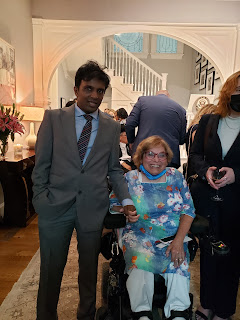Good Job. You're so Brave
I get to meet my hero
I am so in awe and admiration of Judy. I am in so much awe and admiration. This is at the Naval Observatory (VP's residence) to celebrate ADA30.
Conversations with God
Conversations with God
A feeling of lightness
Of bonds breaking free
I look down at my body below
And people that stand around it
Tears on their faces
Anguish in their hearts
They mourn the carrion of flesh and bone
While unshackled, flies my soul
Mourn me not my loved ones.
My words unheard by those below
My mortal body is Maya, mere illusion
Brahman, transcendent reality, is my soul
I will always be with you, dear ones
Grief at start will fade to distant memory
Your dreams and your memories
Are conversations with God really
I travel with angels all around me
Apsaras dance to heaven’s melody
Gloria in excelsis deo
Glory to God in the Highest
O Resplendent Light, Phos Hilaron
I see the face of God before me
Down there at His divine feet
I settle myself down in ecstasy
The Cosmic Director smiles down on me
Are you ready for the next act, asks He.
You may tarry a while in My company
Before I assign you, your next role
Kaala tithaya am I, beyond space and time
Siddha Sankalpaya, My will is instantaneous
I protect and nourish earthkind at all times
For I am verily the Embodiment of Love
Human existence involves, He explains
Births, deaths and rebirths
A karmic cycle of cause and effect
Free will of man plays a mighty role
Free Will I give to man, for I love you most
Use it well in the roles you lead
With spiritual evolution you will reach
Your ultimate destiny, mergence with Me
God recounts the roles of past played by me
Movie clip images, scenes flash before me
Countless colors, countries and lifestyles do I see
In the multitudes of lifetimes I have led.
Ignorant was I, now understanding dawns
Human life is transient at best
Death, a mere comma in the cosmic scheme
So why waste trifles over mortal emotions
To experience Happiness
One must know sorrow
Tests of the morrow
Are but a path to the end
Translations
Maya [Sanskrit]: Illusion
Brahman [Sanskrit]: Absolute Reality
Gloria in excelsis Deo [Latin]: Glory to God in the Highest
Phos Hilaron [Greek]: O Resplendent Light
Kaalatithaya [Sanskrit]: one who is beyond space and time
Siddha Sankalpaya [Sanskrit]: one who’s will is instantaneous and successful
Media Mention
Regressive Autism
Regressive autism, also known as late-onset or acquired autism, is characterized by the loss of previously acquired developmental skills, particularly in social communication and interaction. This regression typically occurs between 15 and 30 months of age, where children may initially develop normally but then experience a decline in verbal communication, social engagement, and may exhibit decreased eye contact, along with an increase in repetitive behaviors. This regression often leads to significant distress for both the child and caregivers.
Explanations and Theories for Regressive Autism
Genetic Factors: There is evidence suggesting a genetic predisposition to regressive autism. Children with this form of autism may have a family history of autism or other developmental disorders, indicating a potential genetic component (Zwaigenbaum et al., 2009).
Environmental Triggers: Environmental factors, such as exposure to certain toxins, infections, or other external stressors, have been hypothesized to trigger regression in children who are genetically predisposed. However, clear causal relationships are not well established (Hertz-Picciotto et al., 2006).
Immune System Abnormalities: Abnormal immune responses or autoimmunity have been linked to regressive autism. Research has identified irregularities in the immune systems of children with autism, which might contribute to the regression of skills (Ashwood et al., 2006).
Neurological Factors: Changes in brain structure and function, including abnormalities in brain development and connectivity, are being explored as potential explanations for regression (Courchesne et al., 2007).
Mitochondrial Dysfunction: Mitochondrial dysfunction, which affects energy production in cells, is another area of research in autism, including regressive forms. Dysfunction in these cellular processes could impact neurodevelopment (Rossignol and Frye, 2012).
Neuronal Pruning: Abnormal neuronal pruning is a significant area of interest. Neuronal pruning is a natural process during brain development where excess neurons and synaptic connections are eliminated to optimize brain function. In autism, including regressive autism, either excessive pruning (leading to a loss of necessary neural connections) or insufficient pruning (resulting in too many synapses) could disrupt normal brain function and development. This disruption may contribute to the loss of previously acquired skills in regressive autism (Tang et al., 2014; Varghese et al., 2017). Genetic studies have linked mutations in genes involved in synaptic pruning, such as MECP2, SHANK3, and PTEN, to autism spectrum disorders (Penzes et al., 2011). [READ MORE ON NEURONAL PRUNING]
Citations
- Zwaigenbaum, L., et al. (2009). The changing epidemiology of autism spectrum disorders. Canadian Journal of Psychiatry, 54(7), 533-540.
- Hertz-Picciotto, I., et al. (2006). The CHARGE study: an epidemiologic investigation of genetic and environmental factors contributing to autism. Environmental Health Perspectives, 114(7), 1119-1125.
- Ashwood, P., et al. (2006). The immune response in autism: a new frontier for autism research. Journal of Leukocyte Biology, 80(1), 1-15.
- Courchesne, E., et al. (2007). Mapping early brain development in autism. Neuron, 56(2), 399-413.
- Rossignol, D. A., & Frye, R. E. (2012). Mitochondrial dysfunction in autism spectrum disorders: a systematic review and meta-analysis. Molecular Psychiatry, 17(3), 290-314.
- Tang, G., et al. (2014). Loss of mTOR-dependent macroautophagy causes autistic-like synaptic pruning deficits. Neuron, 83(5), 1131-1143.
- Varghese, M., et al. (2017). Autism spectrum disorder: neuropathology and animal models. Acta Neuropathologica, 134(4), 537-566.
- Penzes, P., et al. (2011). Dendritic spine pathology in neuropsychiatric disorders. Nature Neuroscience, 14(3), 285-293.




